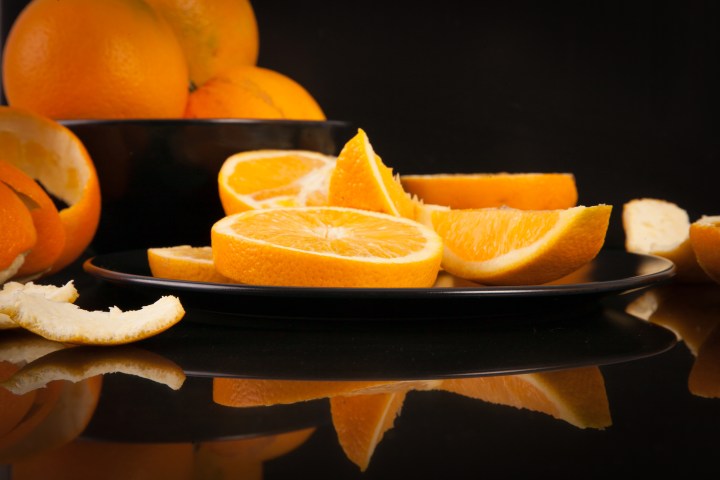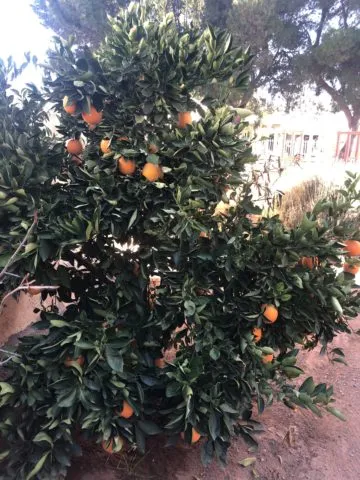MAIN INGREDIENT
An orange tree’s journey

Every life has a story to tell. Even a tree’s.
The author supports Isabelo, chef Margot Janse’s charity which feeds school children every day. Please support them here.
This column accompanies this recipe
My navel orange tree is living an extraordinary life. Born at Starke Ayres in Rondebosch 11 years ago, its first four years were unremarkable. Planted in a deep pot, it stood at the front gate of our little cottage in Tamboerskloof for a year, just a narrow stem with a few leaves, no side shoots whatsoever. It looked unlikely ever to amount to anything, as someone once said of the adolescent me. Three years later, there wasn’t much more to it. But some of us take more time than others to show what we’re made of.
Within a year we had crammed ourselves and everything we owned into a flat in Gardens where not much occurred but for the occasional drinks party happening all around the navel orange in its pot on the back porch and the random cigarette stubbed out in it. Why is it that so many smokers mistake a plant pot for an ashtray? In my 15 years of smoking, long gone, I managed to make the distinction. Anyway.
Then came the second biggest move of our lives (the first had been to England.) Shoved unceremoniously into a dark truck for a juddering drive from Cape Town to Cradock via Beaufort West on the N1 and then across via Aberdeen and Graaff-Reinet to Cradock, the tree, still in its pot, spent six months on the front stoep of Schreiner Bistro barely two metres from that summer’s monster thunderstorms. One monumental hailstorm saw hailstones the size of table tennis balls stacked against the building like snow. I resisted the temptation to plant the tree in the back garden of the bistro. If I had, we would have parted ways within a few short months.
But Daily Maverick called me, a life- and career-changing moment that I treasure. By January we’d managed to buy a house in Cradock and a few months later we moved in. The tree in its pot came with us. In its fifth year our navel found itself in the ground for the first time, the first tree – the first anything – to be planted in the garden to the right of our Cradock house.
But more travel was in store for us, if not the tree. Grahamstown called my wife, so off we went. I wished, in fact, that I hadn’t planted it in the ground, for I felt sure that it would die because the house would be empty until we found a tenant. And there was no guarantee that any tenant would bother to keep the garden alive.
We decamped to Grahamstown for a full year, and though the tree had rooted well and blossomed for the first time before we left Cradock, we could only hope that it would somehow survive 12 months. We chose not to find a tenant.
Almost miraculously, it was still alive the following May, if looking a tad the worse for wear. More wondrous, it had even borne fruit: 10 or so small navel oranges. Funny, I thought, I could have sworn navels were bigger than that. The guy who moved us back, on the back of a white bakkie with a long trailer following behind it, took a break from offloading, picked an orange, bit into it, pulled a face and glowered at me. “This is bitter!”, he chided, fully aware that we had not been living in the house for a full twelvemonth, and he’d moved us to Grahamstown in the first place the previous year.
It’s been four years now since we’ve been back and this hardiest of all navel orange trees is heavy with its most abundant display yet of large, bright fruit. Last year’s harvest gave us many jars of marmalade, plenty of juice, and so much zest for using in my cooking; and I use zest regularly as an aromatic, in both savoury and sweet dishes.
Last year it reached the top of the garden wall, which is about two metres high, and this summer several new branches shot heavenwards about 1.5 metres above the wall. This spring will see us pruning the lower branches so that its now very thick trunk will be bare for a metre or more above ground, to encourage growth and fruit higher up.
It’s abundantly (literally) clear to us now that the variety lives up to what many think is its maritime name, but it’s not naval, it’s navel, named for the tiny belly button of an indent at the root base. It’s large and sweet (unlike the relative bitterness of the Seville orange, also known as bigarade), its juice a joy to drink and its zest lending just the right amount of pizzazz to a sauce or cooking broth.

My orange tree. (Photo: Tony Jackman)
It’s also known as the winter orange; its cousin, the Valencia, being the summer variety. If you’ve ever wondered about that tiny “second” orange you get at the opposite end to the navel, it is in fact regarded as a second fruit, yet underdeveloped.
Odd, isn’t it, that we think of oranges and lemons as chief among all the citrus, with grapefruit, naartjies and all the rest following in their wake. But the orange is a hybrid of a pomelo and a mandarin; the pomelo is the progenitor in the maternal line. The citrus.com website cites a 1917 study which found that the navel was “a single mutation that happened in the early 1800s on a Selecta Orange tree planted in a monastery in Bahia, Brazil. The mutation on this sweet orange caused it to develop a secondary rudimentary fruit at the base, opposite the stem end, nested within the peel of the primary fruit. The said mutation also caused the fruit to be seedless.”
A navel orange tree can grow up to nine metres high, or a bit beyond, which means that the next phase of our tree’s life could see it towering high above the garden wall and rivalling the height of the house. In its once barren side garden it now keeps company with a lemon, a naartjie, a kareeboom, several roses and an olive tree that was planted on our return from Grahamstown four years ago and now stands six metres tall. We’re harvesting oranges this week.
In the meantime, our navel orange tree stands proud in the quiet knowledge that, despite the odds, it did amount to something, and has a lot of life in it yet. DM/TGIFood
To enquire about Tony Jackman’s book, foodSTUFF (Human & Rousseau) please email him at [email protected]



 Become an Insider
Become an Insider
Comments - Please login in order to comment.